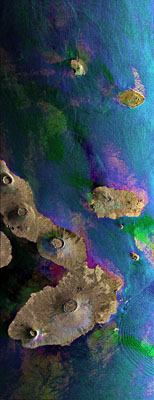Discovered in 1535, the islands became famous in the early 19th century when Charles Darwin wrote On the Origin of Species by Means of Natural Selection, or the Preservation of Favoured Races in the Struggle for Life, based on his observations made on Galapagos. A national park has been established to protect the island’s unique habitat and to ensure the survival of the endangered species.
Galapagos’s largest island is Isabela (visible). The five volcanoes seen on the island are (from north to south): Wolf Volcano, Darwin Volcano, Alcedo Volcano, Sierra Negra Volcano and Cerro Azul Volcano. The bigger island to the right of Isabela is Santiago Island.

Click image for full size. Credit: ESA
Apart from mapping changes on the land surface, radar data can also be used to determine sea surface parameters like wind speed, wind direction and wave height. Different wave types and wind speeds are visible in the image as ripples on the water surface.
Envisat obtained this image by combining three Advanced Synthetic Aperture Radar (ASAR) acquisitions (23 March 2006, 14 August 2008 and 1 January 2009) taken over the same area. The colors in the image result from variations in the surface that occurred between acquisitions.




Comments